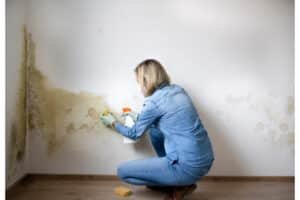
Water damage in the home isn’t just caused by acts of nature like floods. There are lots of little things around the house that could be the source of major and minor water damage. Before you experience a water damage emergency or inconvenience, there are lots of little things and areas that you can check around your house and property to help prevent any impending water damage. To help you out, we created this home maintenance checklist for you to use during the four seasons and year-round!
Spring and Summer Checklist
Spring and summer bring plenty of opportunities to get outdoors and enjoy your backyards, decks, and patios. It also means you may experience water damage due to everything from improperly installed AC units to heavy rains from summer storms. Here’s a list of things to double-check during these seasons:
- Properly Install AC Units – If you’re using window units to air condition your home, be sure to slightly tilt the unit away from your house when you install it. This allows any condensation to run into the drip pan and not into your house causing water damage to your window sills, walls, or floors.
- Inspect Your Roof – Missing or damaged shingles can allow rainwater to seep into your house. To make sure your roof is in good shape, grab a pair of binoculars and take a look at it on an overcast day to prevent sun glare. Please do not climb on your roof to inspect it. You don’t want to cause further damage to your roof – or worse – injure yourself!
- Check Seals & Storm Wind Drains – Cracked caulking or sealing around your windows will not only cause cool air to escape your house (and make your AC work harder) it also acts as a gateway for rainwater damage. Be sure your windows are properly sealed and caulked. Also, if you have an older home with storm window drains, make sure they’re clear of debris to prevent puddling water.
- Check Siding – Warm weather days are a great time to get out the power washer and clean your siding. Before you fire up the washer, make sure your siding isn’t damaged or missing pieces. It’s also a good idea to check your siding after summer storms to make sure heavy winds haven’t ripped off any panels.
- Inspect House Foundation – Another thing you’ll want to do after those heavy summer rains is to inspect your home’s foundation for any visible cracks or signs of water damage.
Fall & Winter Checklist
Just like the spring and summer, fall and winter bring their own unique outlets for water damage. Below are some of the most important things to check to prevent water damage in your home during the cold weather seasons.
- Clean Gutters – Sunny, cool fall afternoons are a great time to get your ladder (and a helper to hold the ladder), climb up to your gutters, and remove any dirt and debris that has accumulated after the trees have shed their leaves. If you don’t clean your gutters, rainwater and snow won’t properly flow away from your house, which will cause all kinds of water damage. Please Note: If you live in a home that has two or more stories, it’s best to call a professional to clean the gutters to prevent injury.
- Turn Off External Faucets – As soon as the weather warmed, you probably turned on the outside faucets and took the hoses out of the garage to water your lawn and plants (and maybe even convince the kids to wash the car). Now that the cold weather is creeping in, it’s time to shut off the water to those external faucets, disconnect the hoses, and put them away. You don’t want water in your external faucets to freeze and cause a burst pipe.
- Check The Sump Pump – If your basement is equipped with a sump pump, the fall and winter months are a good time to make sure it’s working properly. One of the biggest causes of basement flooding during the winter is caused when heavy snows begin to melt. If your sump pump is faulty or broken, it won’t protect your basement from melting snow water from seeping in and damaging your home.
Year-Round Checklist
Ok. You’ve got your checklist for all four seasons. But your home maintenance agenda isn’t complete. There are a few things you can do year-round to make sure your home is free from any potential water damage problems.
- Check Appliance Hoses – Dishwashers, ice makers and washing machines sure make our lives easier. But they can cause major water if their hoses are rotted or disconnected. To avoid any floods caused by faulty hoses, be sure to check them every month or so to make sure they’re not leaking or looking worse for wear.
- Inspect Sinks, Faucets, and Tubs – You use your sinks, showers, and toilets every day, but there’s a good chance you’re not looking at their caulking or sealing, inspecting the pipes in the cabinets below them, or keeping those drains completely free of clogs. It’s a good idea to check these areas out year-round to make sure nothing is leaking or in danger of backing up and overflowing.
By following our handy home maintenance checklist, you should be able to prevent or minimize any water damage to your home. Still, even if you stay on top of these things, unpreventable water damage emergencies can occur. If that happens to you, contact us and we’ll use our innovative, science-based solutions to remove any water and moisture, thoroughly dry the water-damaged areas, and save your home from any unnecessary demolition projects.



